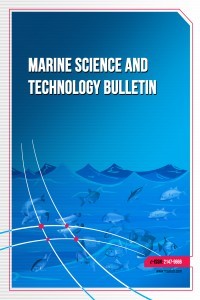
Marine Science and Technology Bulletin
Yazarlar: Hatice ONAY, Sabri BİLGİN
Konular:Balıkçılık
DOI:10.33714/masteb.993252
Anahtar Kelimeler:Portunidae,CPUE,Biomass,Abundance,Crab
Özet: This study was carried out to determine the temporal and spatial distribution of Liocarcinus depurator (Crustacea: Decapod) caught by beam trawl in the southeast Black Sea between December 2012 and November 2013. Sampling was executed at depths from shoreline to deeper 30 m by using a 2 m wide beam trawl from İyidere, Merkez and Çayeli stations. L. depurator was determined most intensely (1000 m 2) at 0-5 m depth at Çayeli station and during the summer season. L. depurator started to migrate from shallow to deeper in autumn and left the coast completely in winter. It approached the shore again in the spring and spread at all depths in the summer season. In addition, while it was distributed in three different habitats according to CPUE values, the highest CPUE value was calculated at Çayeli station, which has a macroalgae structure.